Adlard E.R. (ed.) Chromatography in the Petroleum Industry
Подождите немного. Документ загружается.

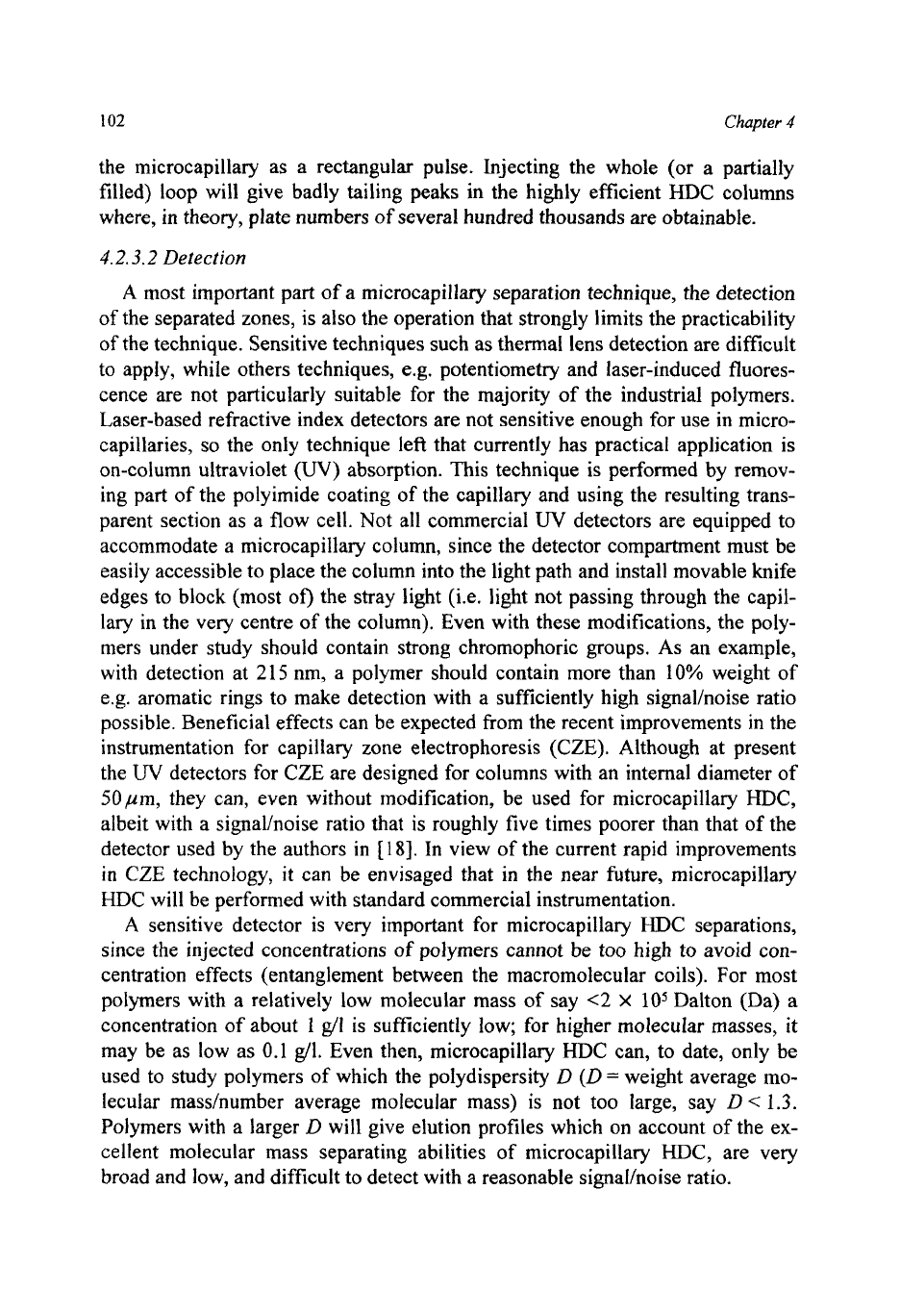
102
Chapter
4
the microcapillary as a rectangular pulse. Injecting the whole (or a partially
filled) loop will give badly tailing peaks in the highly efficient
HDC
columns
where, in theory, plate numbers of several hundred thousands are obtainable.
4.2.3.2
Detection
A
most important part of
a
microcapillary separation technique, the detection
of the separated zones, is also the operation that strongly limits the practicability
of the technique. Sensitive techniques such as thermal lens detection are difficult
to apply, while others techniques, e.g. potentiometry and laser-induced fluores-
cence are not particularly suitable for the majority of the industrial polymers.
Laser-based refractive index detectors are not sensitive enough for use in micro-
capillaries,
so the only technique left that currently has practical application is
on-column ultraviolet
(UV)
absorption. This technique is performed by remov-
ing part of the polyimide coating of the capillary and using the resulting trans-
parent section as a flow cell. Not all commercial
UV
detectors are equipped to
accommodate a microcapillary column, since the detector compartment must be
easily accessible to place the column into the light path and install movable knife
edges to block (most
of)
the stray light (i.e. light not passing through the capil-
lary in the very centre of the column). Even with these modifications, the poly-
mers under study should contain strong chromophoric groups. As an example,
with detection at
215
nm, a polymer should contain more than
10%
weight of
e.g. aromatic rings to make detection with a sufficiently high signalhoke ratio
possible. Beneficial effects can be expected from the recent improvements in the
instrumentation for capillary zone electrophoresis (CZE). Although at present
the
W
detectors for CZE are designed for columns with an internal diameter
of
50,um, they can, even without modification, be used for microcapillary
HDC,
albeit with a signahoise ratio that is roughly five times poorer than that
of
the
detector used by the authors
in
[
181.
In
view of the current rapid improvements
in
CZE
technology, it can be envisaged that
in
the near future, microcapillary
HDC will be performed with standard commercial instrumentation.
A
sensitive detector is very important for microcapillary HDC separations,
since the injected concentrations of polymers cannot be too high to avoid con-
centration effects (entanglement between the macromolecular coils).
For
most
polymers with a relatively low molecular mass of say
<2
X
lo5
Dalton (Da) a
concentration
of
about
1
g/f
is sufficiently
low;
for higher molecular masses, it
may be as low
as
0.1
g/l.
Even then, microcapillary
HDC
can,
to
date, only be
used to
study
polymers of which the polydispersity
D
(D
=
weight average mo-
lecular masshumber average molecular mass) is not too large, say
D
<
1.3.
Polymers with a larger
D
will give elution profiles which on account
of
the ex-
cellent molecular mass separating abilities of microcapillary HDC, are very
broad and low, and difficult to detect with a reasonable signalhoise ratio.
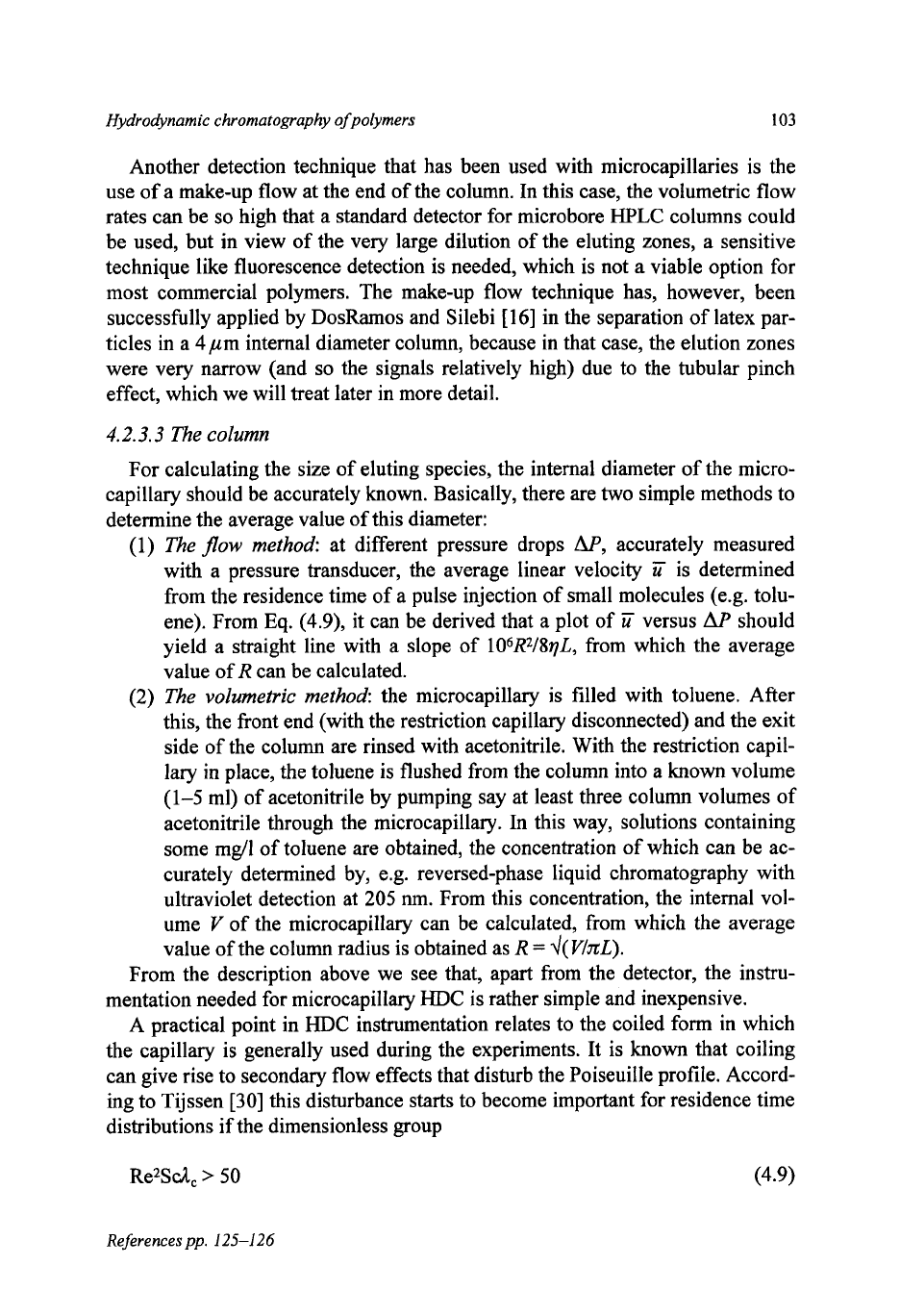
Hydrodynamic chromatography ofpolymers
103
Another detection technique that has been used with microcapillaries is the
use of a make-up flow at the end of the column. In this case, the volumetric flow
rates can be
so
high that a standard detector for microbore HPLC columns could
be used, but in view of the very large dilution of the eluting zones, a sensitive
technique like fluorescence detection is needed, which is not a viable option for
most commercial polymers. The make-up flow technique has, however, been
successfully applied by
DosRamos
and Silebi
[
161
in the separation of latex par-
ticles in a 4 pm internal diameter column, because in that case, the elution zones
were very narrow (and
so
the signals relatively high) due to the tubular pinch
effect, which we will treat later in more detail.
4.2.3.3
The column
For calculating the size of eluting species, the internal diameter of the micro-
capillary should be accurately
known.
Basically, there are
two
simple methods to
determine the average value of this diameter:
(1)
The
flow
method
at different pressure drops
AP,
accurately measured
with a pressure transducer, the average linear velocity
ii
is
determined
from the residence time of a pulse injection of small molecules (e.g. tolu-
ene). From Eq. (4.9), it can be derived that a plot of
ii
versus
AP
should
yield a straight line with a slope of
106R2/8yL,
from which the average
value of
R
can be calculated.
(2)
The volumetric method
the microcapillary
is
filled with toluene. After
this, the front end (with the restriction capillary disconnected) and the exit
side of the column are rinsed with acetonitrile. With the restriction capil-
lary in place, the toluene is flushed from the column into a
known
volume
(1-5
ml) of acetonitrile by pumping say at least three column volumes of
acetonitrile through the microcapillary. In this way, solutions containing
some mg/l of toluene are obtained, the concentration of which can be ac-
curately determined by, e.g. reversed-phase liquid chromatography with
ultraviolet detection at
205
nm. From this concentration, the internal vol-
ume
V
of the microcapillary can be calculated, from which the average
value
of
the column radius is obtained as
R
=
d(
V/nL).
From the description above we see that, apart from the detector, the instru-
mentation needed for microcapillary
HDC
is rather simple and inexpensive.
A practical point in
HDC
instrumentation relates to the coiled form in which
the capillary is generally used during the experiments. It is
known
that coiling
can give rise to secondary flow effects that disturb the Poiseuille profile. Accord-
ing to Tijssen
[30]
this disturbance starts to become important for residence time
distributions if the dimensionless group
Re*Sd,
>
50
(4.9)
References pp.
125-126
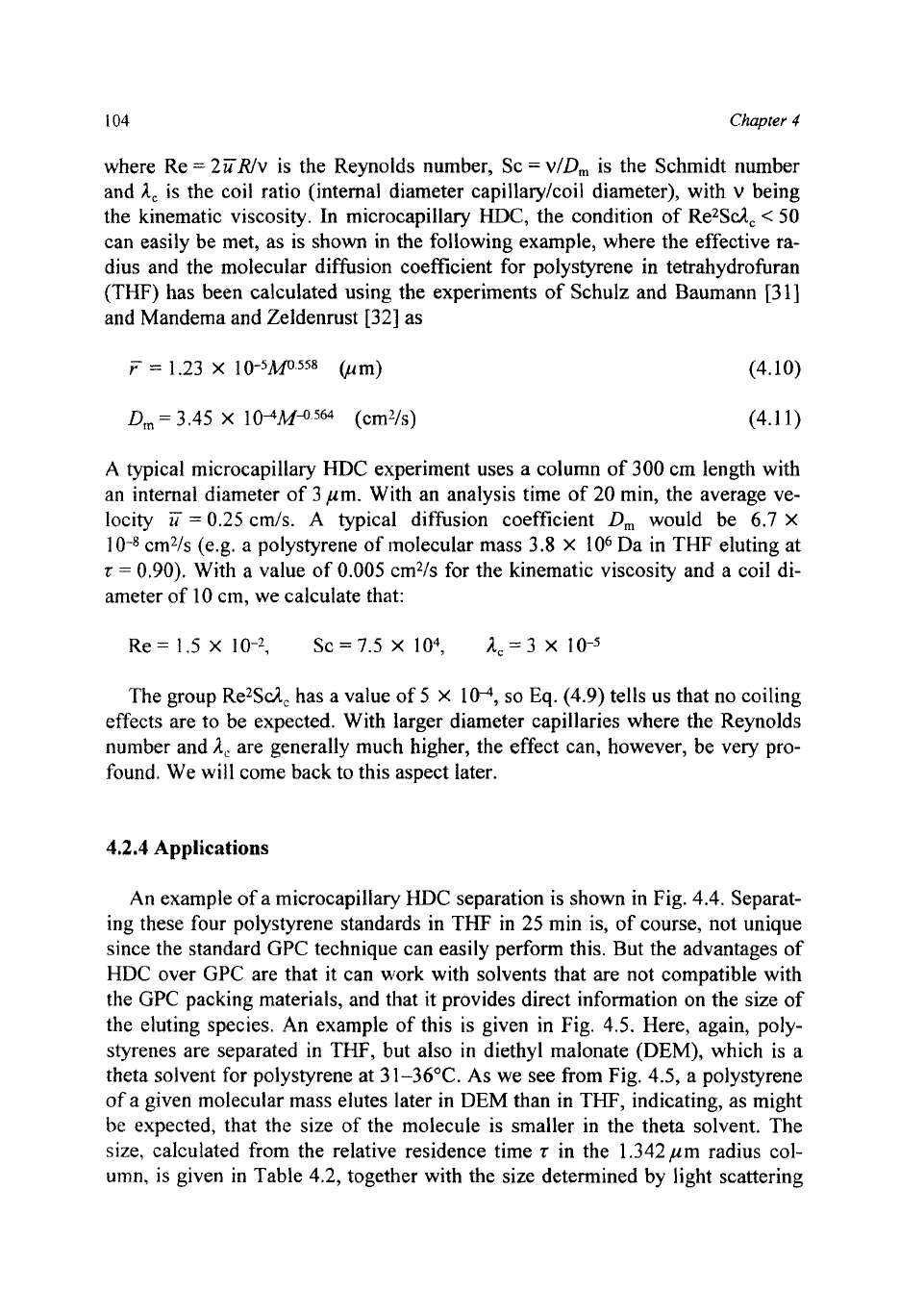
104
Chapter
4
where Re
=
2UNv
is
the Reynolds number, Sc
=
v/D,
is the Schmidt number
and
,Ic
is
the coil ratio (internal diameter capillaqdcoil diameter), with
v
being
the kinematic viscosity. In microcapillary
HDC,
the condition
of
Re2Sdc
<
50
can easily be met, as
is
shown in the following example, where the effective ra-
dius and the molecular diffusion coefficient for polystyrene in tetrahydrofuran
(THF) has been calculated using the experiments
of
Schulz and Baumann [31]
and Mandema and Zeldenrust
[32]
as
F
=
1.23
X
10-5Mo,558
Olm) (4.10)
D,=3.45
x
104M-0.564 (cmVs)
(4.1
1)
A
typical microcapillary
HDC
experiment uses a column of
300
cm length with
an internal diameter of 3 pm. With an analysis time of
20
min, the average ve-
locity
U
=
0.25
cm/s.
A typical diffusion coefficient
D,
would be 6.7
x
1
0-8
cm2/s (e.g. a polystyrene
of
molecular mass
3.8
X
lo6
Da in THF eluting at
z
=
0.90). With a value
of
0.005
cm2/s for the kinematic viscosity and a coil di-
ameter
of
10 cm, we calculate that:
Re= 1.5
x
Sc=7.5
x
104,
1,=3
x
The group Re2Sd, has a value
of
5
X
lo4,
so
Eq. (4.9) tells us that no coiling
effects are to be expected. With larger diameter capillaries where the Reynolds
number and
1,
are generally much higher, the effect can, however, be very pro-
found. We will come back to this aspect later.
4.2.4
Applications
An example of a microcapillary
HDC
separation is shown in Fig.
4.4.
Separat-
ing these four polystyrene standards in THF in
25
min is,
of
course, not unique
since the standard
GPC
technique can easily perform this. But the advantages
of
HDC over
GPC
are that it can work with solvents that are not compatible with
the
GPC
packing materials, and that it provides direct information on the size of
the eluting species. An example of this is given in Fig.
4.5.
Here, again, poly-
styrenes are separated in THF, but also
in
diethyl malonate (DEM), which is a
theta solvent
for
polystyrene at
3
1-36°C.
As we see
from
Fig. 4.5, a polystyrene
of
a given molecular mass elutes later in DEM than in THF, indicating, as might
be
expected, that the size of the molecule is smaller in the theta solvent. The
size, calculated from the relative residence time
z
in the 1.342pm radius col-
umn,
is
given
in
Table
4.2,
together with the size determined by light scattering
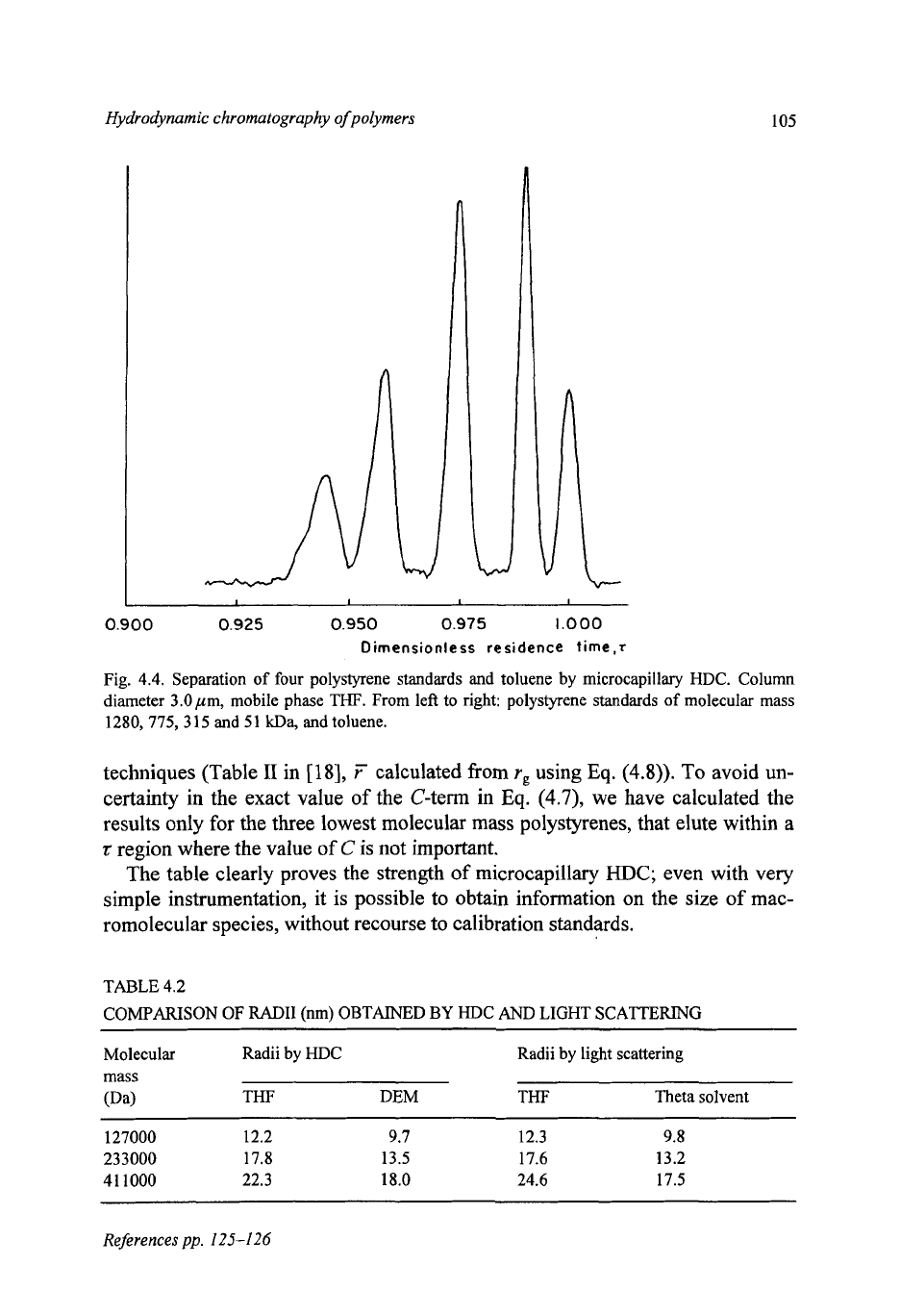
Hydrodynamic chromatography
of
polymers
105
0.900
0.925 0.950 0.975
1.000
Dimensionless residence time
,r
Fig. 4.4. Separation
of
four
polystyrene standards and toluene by microcapillary HDC. Column
diameter
3.0pm,
mobile phase THF. From left to right: polystyrene standards
of
molecular mass
1280,775,315 and 51
kDa,
and toluene.
techniques (Table
I1
in
[18],
U
calculated
from
rg
using
Eq.
(4.8)).
To avoid un-
certainty in the exact value of the C-term in Eq.
(4.7),
we have calculated the
results only for the three lowest molecular mass polystyrenes, that elute within a
z
region where the value
of
C
is
not important.
The table clearly proves the strength
of
microcapillary
HDC;
even with very
simple instrumentation, it
is
possible to obtain information on the size of mac-
romolecular species, without recourse to calibration standards.
TABLE 4.2
COMPARISON
OF
RADII
(nm) OBTAINED
BY
HDC AND LIGHT
SCA'ITERING
Molecular Radii by HDC Radii by light scattering
mass
Pa) THF
DEM
THF Theta solvent
127000 12.2 9.7 12.3 9.8
233000 17.8 13.5 17.6 13.2
41 1000 22.3 18.0 24.6 17.5
~
References
pp.
125-126
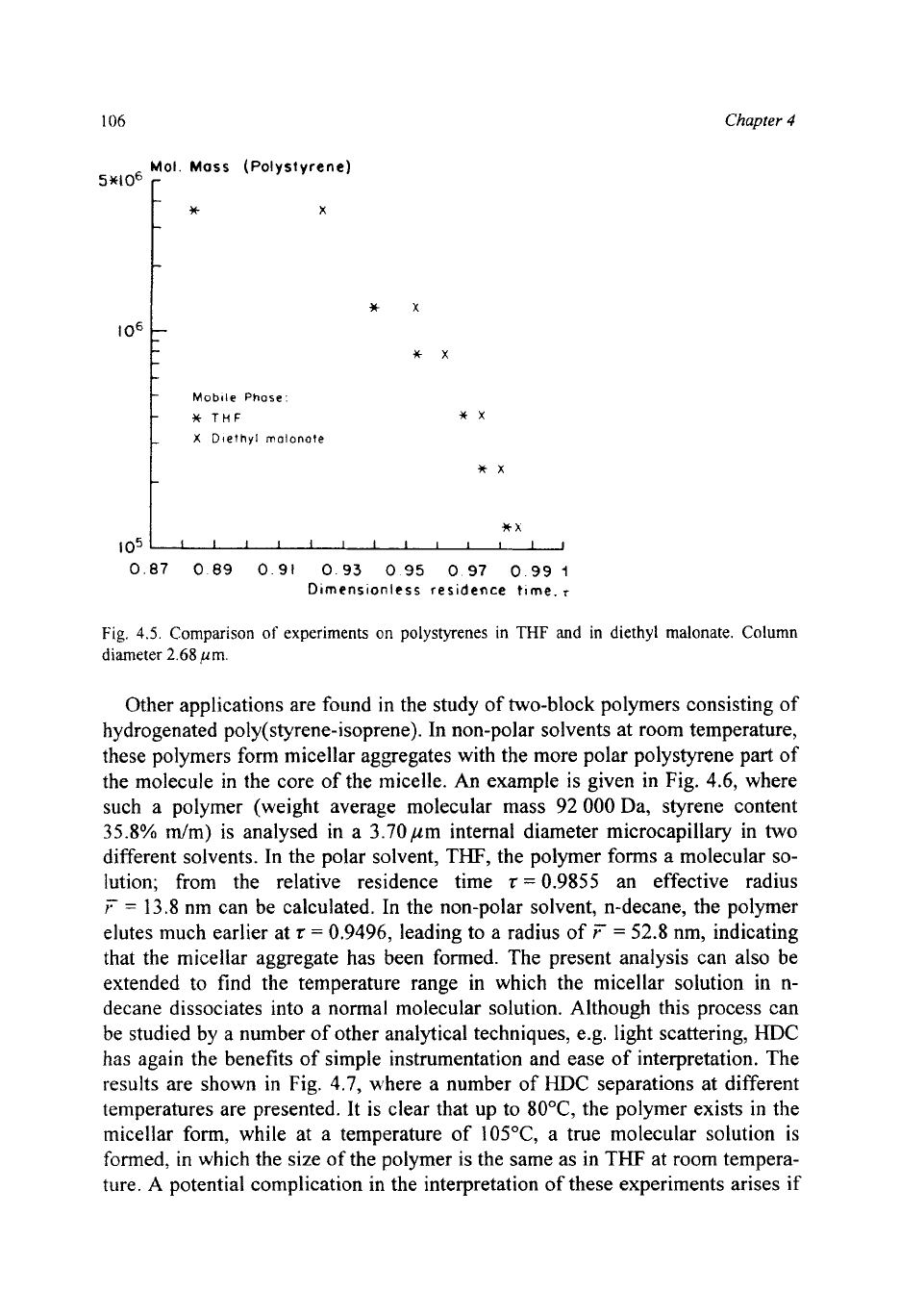
106
Chapter
4
Mol.
Moss
(Polystyrene)
SWIO~
r
*
X
X
XX
Mobile
Phose'
3c
THF
X
Dlethyl
rnolonote
*x
I
*x
*x
1051
I
I
11
1
11
8
I
I
I
0
87
0
89
0
91
0
93
0
95
0
97
0
99
1
Dimensionless
resldence
tlme.
r
Fig.
4.5.
Comparison
of
experiments
on
polystyrenes
in
THF
and in diethyl malonate. Column
diameter
2.68
pm.
Other applications are found in the study of two-block polymers consisting of
hydrogenated poly(styrene-isoprene). In non-polar solvents at room temperature,
these polymers
form
micellar aggregates with the more polar polystyrene part of
the molecule
in
the core
of
the micelle.
An
example
is
given in Fig. 4.6, where
such
a
polymer (weight average molecular
mass
92
000
Da, styrene content
35.8% dm) is analysed in a 3.70,um internal diameter microcapillary in
two
different solvents. In the polar solvent,
THF,
the polymer forms a molecular
so-
lution; from the relative residence time
t
=
0.9855 an effective radius
I'
=
13.8
nm can be calculated. In the non-polar solvent, n-decane, the polymer
elutes much earlier at
t
=
0.9496, leading to a radius of
V
=
52.8 nm, indicating
that the micellar aggregate has been formed. The present analysis can also be
extended to find the temperature range in which the micellar solution in n-
decane dissociates into a normal molecular solution. Although this process can
be studied by a number of other analytical techniques, e.g. light scattering,
HDC
has again the benefits of simple instrumentation and ease of interpretation. The
results are shown
in
Fig. 4.7, where a number of
HDC
separations at different
temperatures are presented. It
is
clear that up to 80°C, the polymer exists in the
micellar form, while at a temperature of
105"C,
a true molecular solution is
formed, in which the size
of
the polymer is the same as in
THF
at room tempera-
ture. A potential complication in the interpretation of these experiments arises if
-
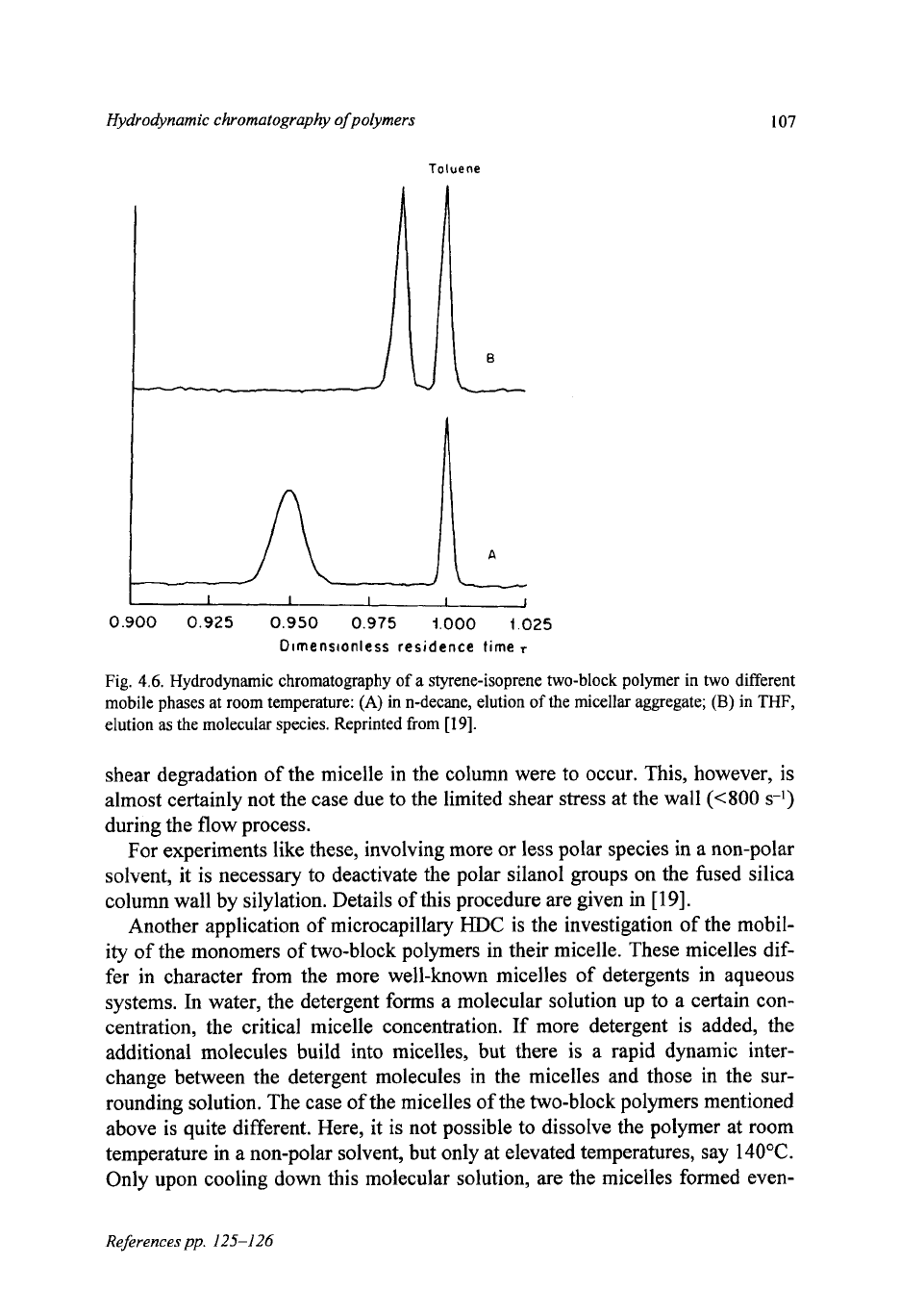
Hydrodynamic chromatography
of
polymers
107
Toluene
I
I
I
I
1
I
0.900
0.925
0.950
0.975
1.000
1.025
Dimensionless residence time
Fig.
4.6.
Hydrodynamic chromatography of a styrene-isoprene two-block polymer in
two
different
mobile phases at room temperature:
(A)
in
n-decane, elution
of
the micellar aggregate;
(B)
in THF,
elution
as
the molecular species. Reprinted from
[19].
shear degradation of the micelle
in
the column were to occur. This, however, is
almost certainly not the case due to the limited shear stress at the wall
(<SO0
s-')
during the flow process.
For experiments like these, involving more or less polar species in a non-polar
solvent, it is necessary to deactivate the polar silanol groups on the fused silica
column wall by silylation. Details of this procedure are given in
[
191.
Another application of microcapillary
HDC
is the investigation of the mobil-
ity
of
the monomers of two-block polymers in their micelle. These micelles dif-
fer in character from the more well-known micelles of detergents in aqueous
systems.
In
water, the detergent forms a molecular solution up to a certain con-
centration, the critical micelle concentration. If more detergent is added, the
additional molecules build into micelles, but there
is
a rapid dynamic inter-
change between the detergent molecules in the micelles and those in the sur-
rounding solution. The case of the micelles of the two-block polymers mentioned
above is quite different. Here, it is not possible to dissolve the polymer at room
temperature in a non-polar solvent, but only at elevated temperatures, say
140°C.
Only upon cooling down this molecular solution, are the micelles formed even-
References pp.
125-126
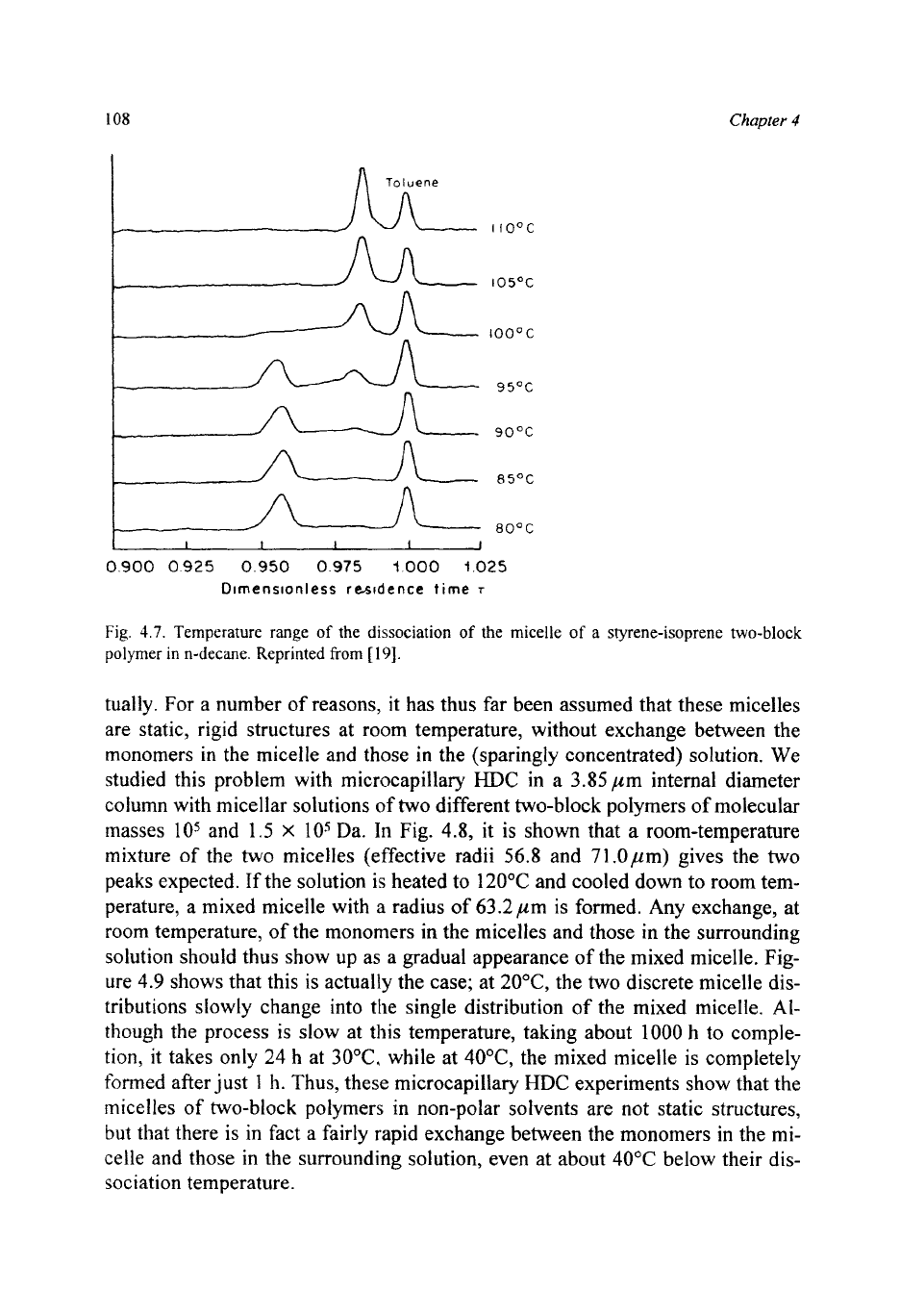
I08
Chapter
4
1
I
I
I
I
I
0.900
0.925
0.950
0.975
1.000
1.025
Dimensionless
residence
time
r
Fig.
4.7.
Temperature
range
of
the dissociation
of
the
micelle
of
a
styrene-isoprene two-block
polymer
in n-decane. Reprinted
from
[
191.
tually.
For
a number of reasons, it has thus far been assumed that these micelles
are static, rigid structures at room temperature, without exchange between the
monomers in the micelle and those
in
the (sparingly concentrated) solution. We
studied this problem with microcapillary HDC in a 3.85pm internal diameter
column with micellar solutions of two different two-block polymers
of
molecular
masses
105
and
1.5
X
los
Da. In Fig.
4.8,
it is shown that
a
room-temperature
mixture
of
the two micelles (effective radii 56.8 and
71.0pm)
gives the
two
peaks expected. If the solution is heated to
120°C
and cooled down to room tem-
perature, a mixed micelle with a radius of 63.2pm
is
formed. Any exchange, at
room temperature, of the monomers in the micelles and those in the surrounding
solution should thus show up as a gradual appearance of the mixed micelle. Fig-
ure
4.9
shows that this is actually the case; at 20"C, the
two
discrete micelle dis-
tributions slowly change into the single distribution of the mixed micelle. Al-
though the process is slow at this temperature, taking about
1000
h to comple-
tion, it takes only 24 h at 30°C while at
40"C,
the mixed micelle is completely
formed after just
1
h. Thus, these microcapillary
HDC
experiments show that the
micelles of two-block polymers in non-polar solvents are not static structures,
but that there
is
in fact a fairly rapid exchange between the monomers in the mi-
celle and those in the surrounding solution, even at about 40°C below their dis-
sociation temperature.
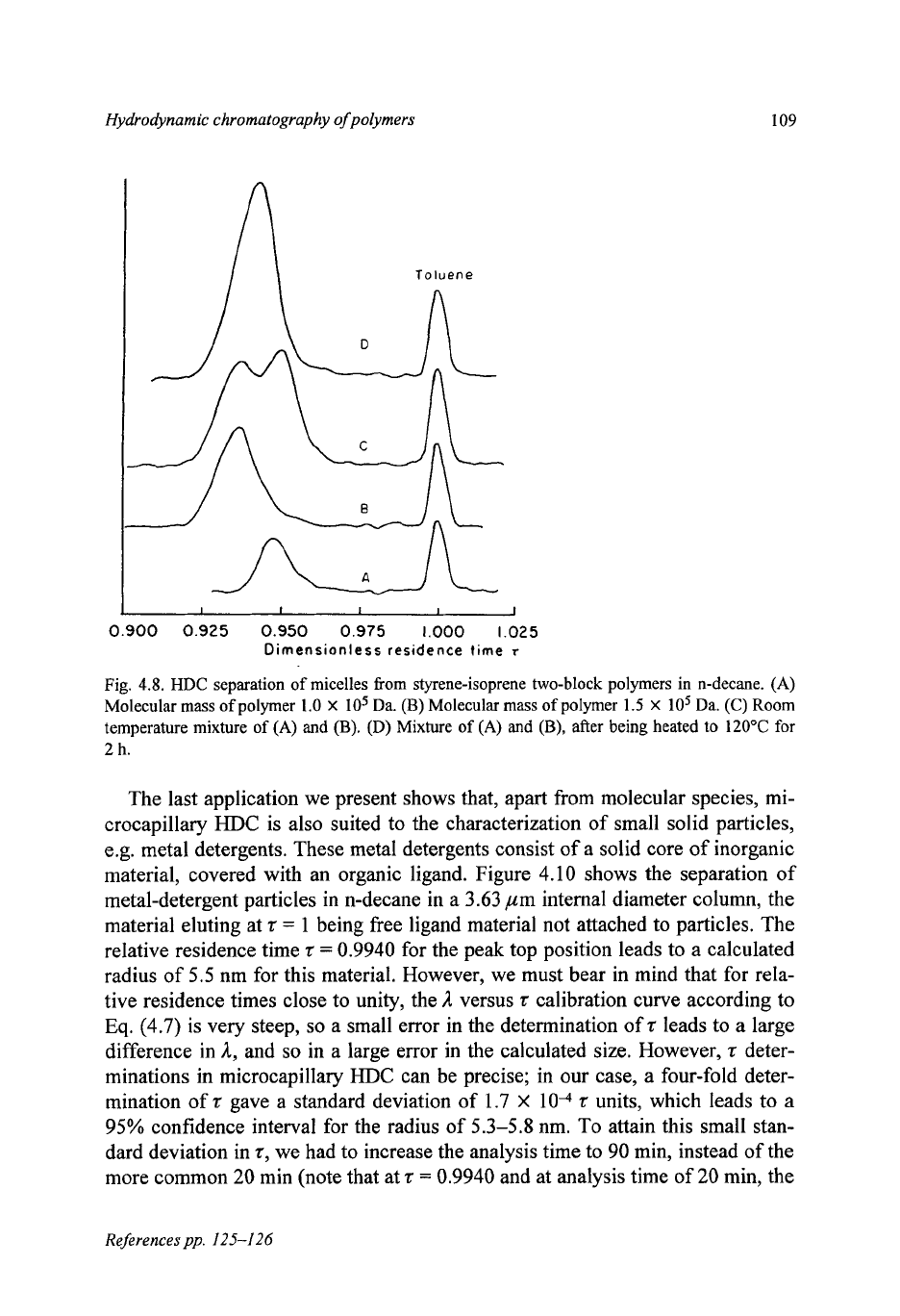
Hydrodynamic chromatography ofpolymers
109
1
I
I
I
1
I
0.900
0.925 0.950
0.975
1.000
1.025
Dimensionless residence time
r
Fig.
4.8.
HDC
separation
of
micelles from styrene-isoprene two-block polymers in n-decane.
(A)
Molecular mass
of
polymer
1.0
X
lo5
Da.
(B)
Molecular mass
of
polymer
1.5
X
lo5
Da.
(C)
Room
temperature mixture
of
(A)
and
(B).
(D)
Mixture
of
(A)
and
(B),
after being heated to
120°C
for
2
h.
The last application we present shows that, apart from molecular species, mi-
crocapillary
HDC
is
also suited to the characterization of small solid particles,
e.g. metal detergents. These metal detergents consist of a solid core
of
inorganic
material, covered with an organic ligand. Figure 4.10 shows the separation of
metal-detergent particles in n-decane in a 3.63 pm internal diameter column, the
material eluting at
t
=
1 being free ligand material not attached to particles. The
relative residence time
t
=
0.9940 for the peak top position leads to a calculated
radius of 5.5 nm for this material. However, we must bear in mind that for rela-
tive residence times close to unity, the
;Z
versus
t
calibration curve according to
Eq.
(4.7) is very steep,
so
a small error in the determination of
t
leads to a large
difference in
A,
and
so
in
a large error in the calculated size. However,
t
deter-
minations in microcapillary
HDC
can be precise; in our case, a four-fold deter-
mination of
t
gave a standard deviation of
1.7
X
lo4
t
units, which leads to a
95% confidence interval for the radius of 5.3-5.8 nm.
To
attain this small stan-
dard deviation in
t,
we had to increase the analysis time to 90 min, instead of the
more common
20
min (note that at
t
=
0.9940 and at analysis time of
20
min, the
References pp.
125-126
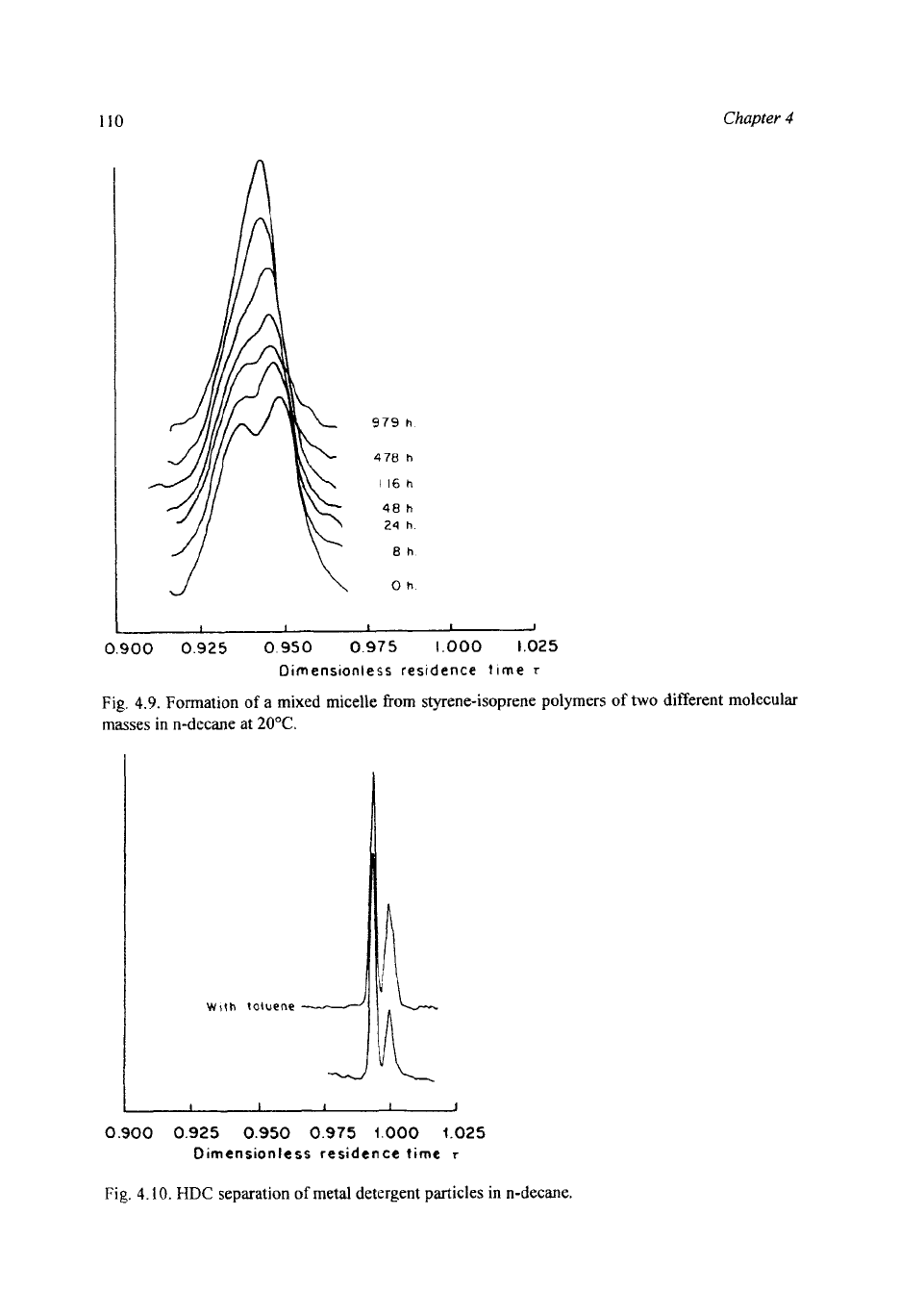
Chapter
4
n
110
0.900
0.925
0.950
0.975
1.000
1.025
Dimensionless residence time
T
979
h
478
h
I16
h
48
h
24
h
8h
Oh
Fig. 4.9.
Formation
of
a
mixed micelle from styrene-isoprene polymers
of
two
different molecular
masses
in n-decane at
20°C.
0.900
0.925
0.950
0.975
1.000
1.025
Dimensionless residence time
r
Fig.
4.10.
HDC
separation
of
metal detergent particles
in
n-decane.
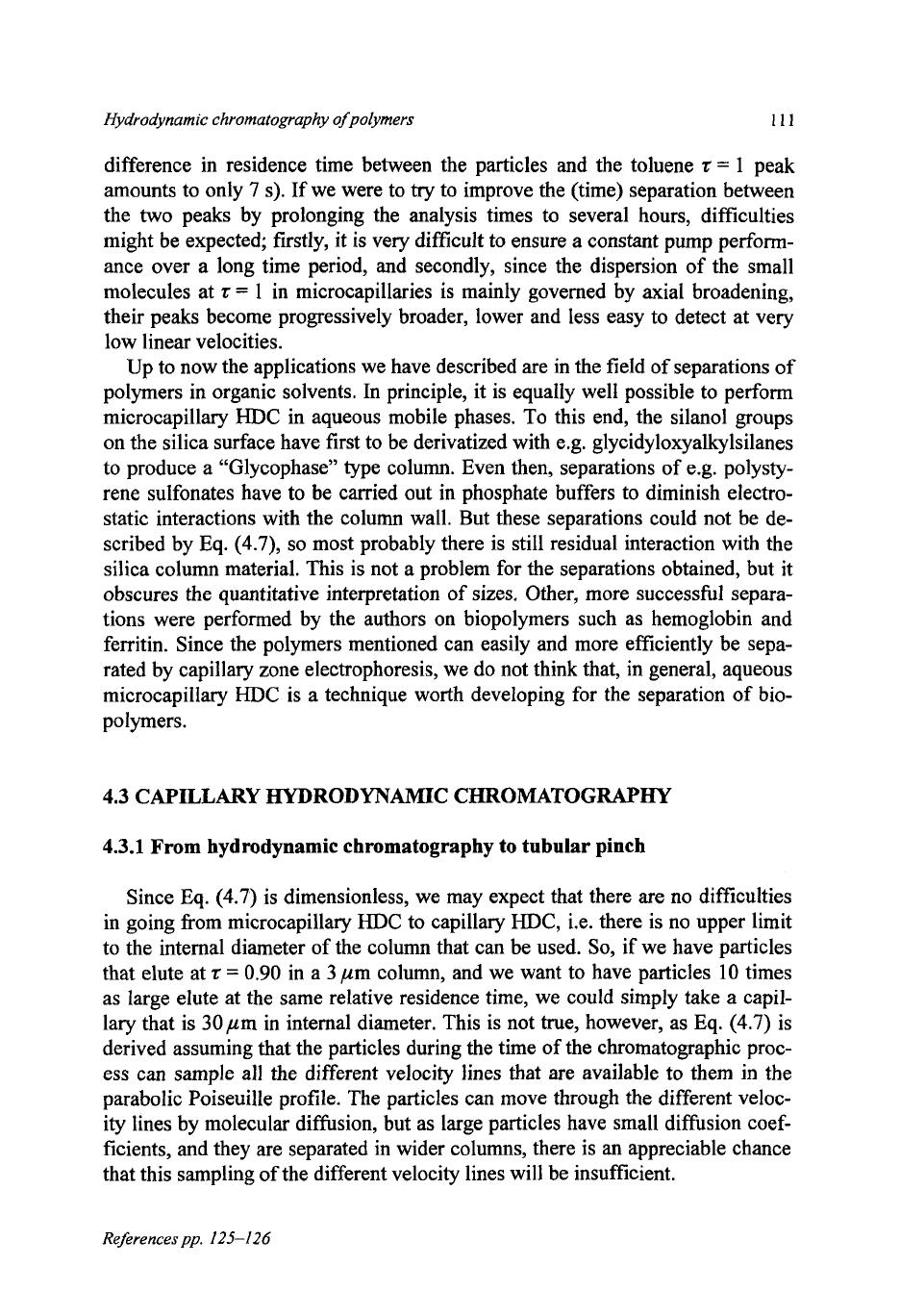
Hydrodynamic chromatography ofpolymers
111
difference in residence time between the particles and the toluene
t
=
1
peak
amounts to only
7
s).
If we were to
try
to improve the (time) separation between
the
two
peaks by prolonging the analysis times to several hours, difficulties
might
be
expected; firstly, it is very difficult to ensure a constant pump perform-
ance over a long time period, and secondly, since the dispersion of the small
molecules at
t
=
1
in microcapillaries is mainly governed by axial broadening,
their peaks become progressively broader, lower and less easy to detect at very
low linear velocities.
Up to now the applications we have described are in the field of separations of
polymers in organic solvents. In principle, it is equally well possible to perform
microcapillary
HDC
in aqueous mobile phases. To this end, the silanol groups
on the silica surface have first to be derivatized with e.g. glycidyloxyalkylsilanes
to produce a “Glycophase” type column. Even then, separations of e.g. polysty-
rene sulfonates have to be carried out in phosphate buffers to diminish electro-
static interactions with the column wall. But these separations could not be de-
scribed by Eq.
(4.7),
so
most probably there is still residual interaction with the
silica column material. This is not a problem for the separations obtained, but it
obscures the quantitative interpretation of sizes. Other, more successhl separa-
tions were performed by the authors on biopolymers such as hemoglobin and
ferritin. Since the polymers mentioned can easily and more efficiently be sepa-
rated by capillary zone electrophoresis, we do not think that, in general, aqueous
microcapillary
HDC
is
a technique worth developing for the separation of bio-
polymers.
4.3
CAPILLARY HYDRODYNAMIC CHROMATOGRAPHY
4.3.1 From hydrodynamic chromatography to tubular pinch
Since Eq.
(4.7)
is dimensionless, we may expect that there
are
no difficulties
in going from microcapillary
HDC
to capillary
HDC,
i.e. there
is
no upper limit
to the internal diameter of the column that can be used.
So,
if we have particles
that elute at
t
=
0.90
in a
3
pm
column, and we want to have particles
10
times
as large elute at the same relative residence time, we could simply take a capil-
lary that is 30pm in internal diameter. This is not true, however, as Eq.
(4.7)
is
derived assuming that the particles during the time of the chromatographic proc-
ess can sample all the different velocity lines that are available to them in the
parabolic Poiseuille profile. The particles can move through the different veloc-
ity lines by molecular diffusion, but as large particles have small diffusion coef-
ficients, and they are separated in wider columns, there is an appreciable chance
that this sampling of the different velocity lines will be insufficient.
Refirences
pp.
125-126
